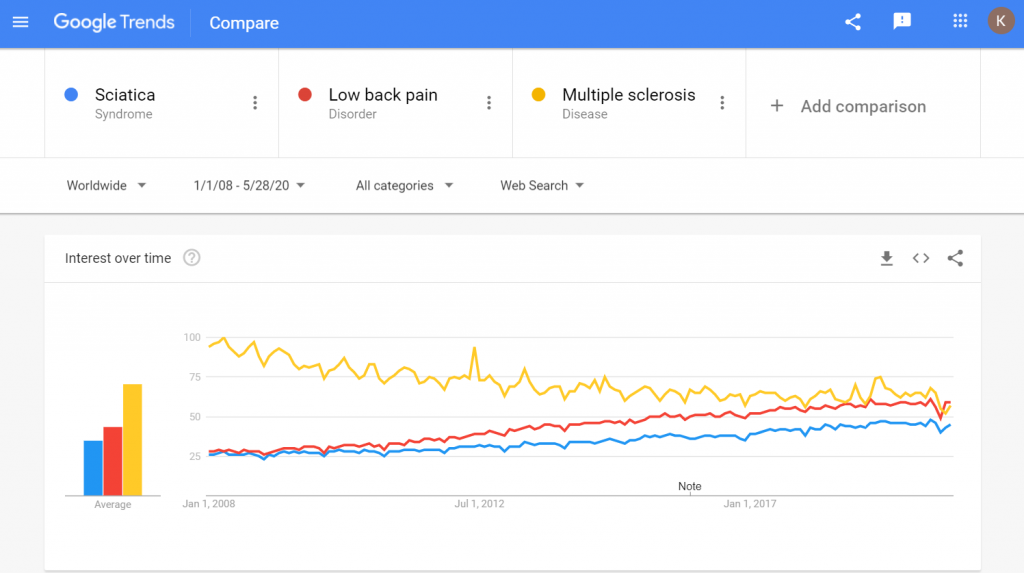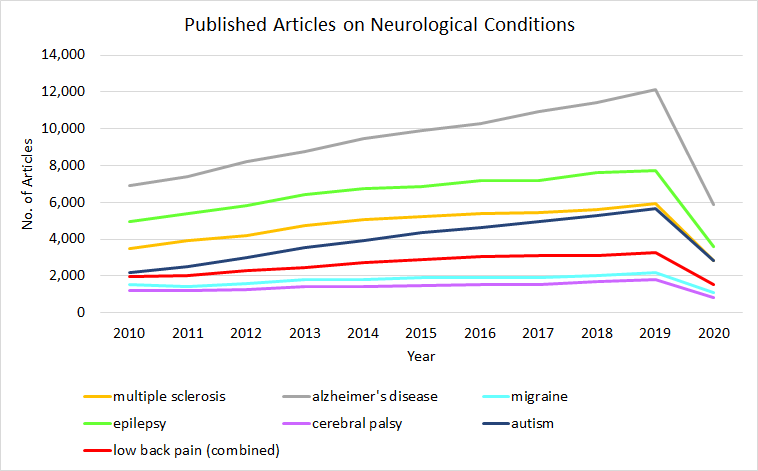Okay, okay, I know – science is supposed to be unbiased. And a responsible scientist will do her best to check her opinions at the door. But honestly, I love a good research article that confirms something I already know. Which is why I enjoyed “Sciatica: Internet Search Trends” more than I probably should.
As research papers go, this one was fairly easy to follow. The authors checked sites commonly used by patients to research health conditions (Wikipedia and Google) against the published article record in PubMed.
The Public View
Because the authors searched publicly accessible platforms, I was able to recreate their data. First, I turned to Google Trends to examine search trends.
Unsurprisingly (to me, anyway), the authors reported that searches for “Sciatica” and the related term “Low back pain” have been increasing over time. My thought was, of course! But doesn’t that just prove we rely on Google more for everything now?
Not necessarily. The authors noted that searches for other neurological conditions have actually decreased. They used “Multiple sclerosis” as a comparison.
When I checked, I saw that sure enough, sciatica and LBP trended up, while searches for MS decreased.

It’s worth noting that Google Trends doesn’t show the exact number of searches, just the comparative popularity of a search term over time. So we know that there are more searches for “Low back pain” than “Sciatica”, but we don’t know how wide the gulf is.
I also checked a few other common neurological disorders, to see how they would compare. I concluded that the term “Multiple sclerosis” did seem cherry-picked to provide a nice counterexample to “Sciatica” and “Low back pain”, though I wouldn’t call it deceptive. The other results don’t prove the point as well, but they don’t paint a dramatically different picture either.
“Alzheimer’s disease”, “Epilepsy”, and “Cerebral palsy” held reasonably steady over time, though each had peaks and valleys. “Migraine” rose in tandem with sciatica and LBP. The most interesting pattern was for “Autism”, which spikes reliably every April.

I had to spend some time getting up to speed on the Wikipedia Massviews Analysis tool, but once I did, it was actually pretty cool. The data only goes back to July 2015, which appears to be why the authors of the paper used a different time frame for the Wikipedia search.
Again, I was able to confirm their results. The Wikipedia page for Sciatica is indexed under four categories, and the rankings in each were as follows:
- Orthopedic problems: 1 of 29 pages
- Peripheral nervous system disorders: 2 of 59 pages
- Symptoms and signs: musculoskeletal system: 1 of 25 pages
- Pain: 1 of 135 pages
I was less surprised by the rankings, and more surprised by how sciatica pulled so far ahead of the pack. In the “Pain” category, “Sciatica” averaged 3,141 pageviews a day, compared to 1,884 daily pageviews for the second-place page “Analgesic”.
This was all a very interesting trip down a data rabbit hole, but why should we care? Basically, this data shows that sciatica and low back pain are both popular topics among the public, and indicates that interest is growing.
The Research
I turned my attention to PubMed. Here, it was interesting to see the comparative results for “sciatica” versus “low back pain”. (I also threw in “leg pain AND lumbar” so that I could properly compare my results to the authors’.) Three guesses as to which was most popular.
While the authors only looked at the number of articles published in 2018, I expanded my search so I could examine the trends over time.
Most surprising to me was the discrepancy between the number articles on “low back pain” versus “sciatica”. If I had any doubts about which topic was the unloved child, they were laid to rest. From 2010-2020, there were twelve times as many articles on “low back pain”.
On a side note, I get annoyed when medical professionals insist I have “low back pain” not “sciatica”. I get that “low back pain” is a broader term, but I can’t resist thinking that its prevalence has served to erase an important distinction.
Next, I wanted to see how LBP & friends compared to other neurological conditions in terms of research output. This chart gets a little messy, so bear with me. Note that the “low back pain (combined)” line includes the total for “low back pain”, “sciatica”, and “leg pain AND lumbar”.

It turns out low back pain is one of the losers of the neurological world, down there with migraine and cerebral palsy. Alzheimer’s was king among this cohort. (Since most research is funded by government entities, this probably, “These old people are too expensive.”)
What Does This Mean?
“Sciatica” is a subject of great interest to the public, but for researchers, it’s barely an afterthought. Scientific interest in sciatica is dwarfed by that in the broad but nebulous “low back pain.” And interest in low back pain is in turn dwarfed by that in other neurological conditions. (There’s always a bigger fish.)
While I didn’t dive into this claim, the authors note that YouTube videos for searches related to sciatica often yield low-quality information. From personal experience, I know that many top results on sciatica contain outdated, misleading, or unhelpful information. I also know that, if you are Googling sciatica at all, it is probably with some degree of desperation, and you deserve better than a paid ad.
I certainly hope that in the near future, the research will increase to match the public need. I also hope that scientists and science writers do more to promote updated and comprehensive information about sciatica and related treatment options. And while I’m at it, I hope that someday our cars will run on children’s smiles and spam callers will only dial each other. In the meantime, I’ll keep looking for the gems in the data.
